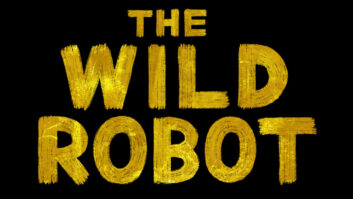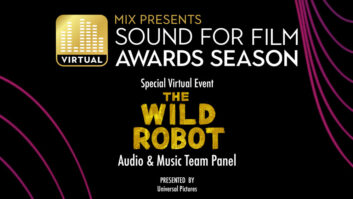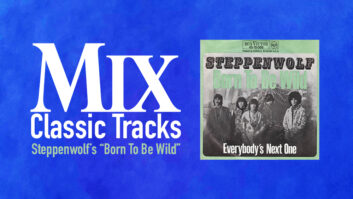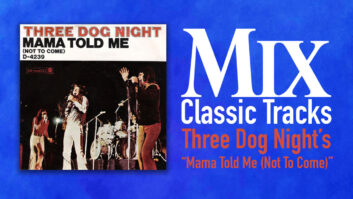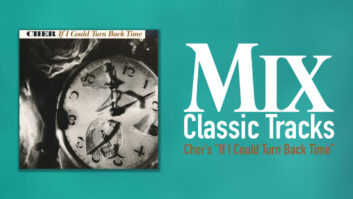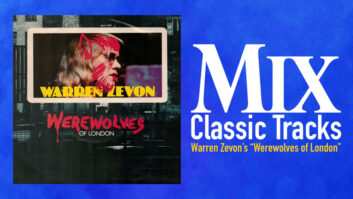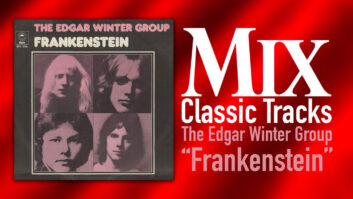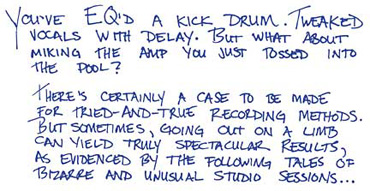

Guitars on ice: The Antarctic team jams atop their research tent.
FIDDLERS ON THE ROOF
Last year was my fourth year working as a research SCUBA diver in the U.S. Antarctic Program. I was also moonlighting as producer, soundtrack composer and underwater cameraman for a new Werner Herzog feature for Discovery Channel International that was filming at the same time down there on the ice. After my science boss, Sam Bowser, made a new scientific discovery about single-celled foraminifera eating larger multi-cellular creatures, what else was there to do but go up on the roof of our field camp’s tent, next to the frozen Ross Sea where our diving takes place, and play loud electric guitars? Werner and his cameraman Peter Zeitlinger naturally had to film this peculiar activity in the clear and frigid Antarctic air. Werner had been using a fancy Cantar recorder to record the sound, but its user interface seemed to be only comprehensible to those whose native language was French, so at this point in the filming, he discarded it and recorded directly to the Blu-ray disk in the fancy new Sony HDV cameras that we were using. The real trick down there, both for recording and for playing, is not to freeze your fingers.
— Henry Kaiser
Click here for extra pix from Fiddlers on the Roof.
THE ANTI-MARTHA STEWART
In the pursuit of a gong/cymbal replacement, I turned to my metal patio furniture. The round, roughly 6-foot tabletop is fortunately not connected to the legs. It has rounded edges and a hole in the middle for an umbrella. The first challenge was figuring out how to mount it. Lifting it up and shaking it produced a wonderful thunder-sheet effect, but I also wanted to take mallets to it. I found that the large drum tube hardware normally used for tom-toms worked nicely. My crescendo roll produced a deliciously unique “trash gong cymbal” sound with a quick decay. When my young son came in to play, he, of course, opened up my percussion toy box and we discovered that the Japanese bowl resting on top of the café table made a wonderful racket. I just made sure my two small-diaphragm condensers captured every nuance in stereo.
— Tom Zehnder

CAN YOU HEAR ME NOW?
Team Fat was booked to play in the guise of a surf band for the Classic Games Convention. It doesn’t really matter that in the Classic Gaming era we dominated the American PC game audio business for, like, five years. Team Fat playing as a surf band is kind of like Buckaroo Banzai’s Hong Kong Cavaliers band playing a gig: Nobody knows who the heck we are, nor do they care. “I don’t care if you drove through solid rock this morning; in my joint, there’ll be no trouble.” This is fine with us; we’re just goofin’ anyway.
But the band that promised us that we could use their equipment spaced and left early with pretty much all of the gear. We talked them into leaving some drum set parts that they kindly trusted us to ship when we were done with ’em. Seth Sternberger (8-Bit Weapon) and I had just met — we ran around the conference looking for things to use as a bass drum. We ended up using his keyboard case. No bass drum means no mount for the toms, so the chairs were used as stands. Also, the keyboard case had to be roped to the chair to keep it from slipping.

Team Fat’s surf band at the Classic Games Convention
The guitars were then plugged into Seth’s P.A. I had a POD, which is cool, but Joe had no effects. And as Mix readers know, there’s nothing less surf-like than a guitar gone straight into the P.A., but there was pretty much nothing we could do about it.
Then Kevin and Dave realized that they had “free weekend minutes,” whatever that meant, on their fancy new cell phones. So for a couple of tunes, we had Dave call Kevin, and one assistant held one phone to the P.A. speaker and one held one to the announcements mic. The sound came out the speaker, into one phone, beamed to outer space, bounced off a satellite, came out the other phone, into the mic, fed back into the P.A. and — presto! — space-age echo. It sounded awesome.
— George Sanger (aka The Fat Man)
AXE ABUSE
First, I duct-taped a cheap guitar to a long cable…then I recorded it through a Marshall stack as it bounced down three flights of stairs. Then after it landed, I tightened the strings until they snapped while the thing fed back like crazy.
Now that’s a crash-and-burn ending!
— Anthony Resta
GONE OFF THE DEEP END
While producing in Australia, we were doing a song about driving your car into the ocean. It needed a big finish: We sunk a shotgun mic (covered in plastic, of course) into the studio swimming pool and loaded a Marshall combo (thankfully not vintage) on to the diving board. As the guitar player hit the last chord, we bounced the amp into the pool, recording the aquatic barrage and ensuing explosion! I don’t think you could do that in the States.
— Jordan Tishler
MICS ON A TRAIN
One of my main clients is the model train company Lionel Trains. We develop unique sound effect systems for Lionel’s products. The systems are not simple playback loops, but rather complex simulations of a variety of sound sources (engine sounds, compressors, brakes, whistles, etc.) that can be triggered in various ways in response to the operator’s commands. Lionel ships a unique set of sounds with each model, and we always strive to use authentic sound sources for these products.

So it was, when Lionel recently inked a deal with the New York City Transit Authority to produce a model of one of their classic New York City subway trains that I was dispatched to the city to record sounds from a set of vintage subway cars. I grew up in the city, riding the subway to and from school every day, so it was a real treat to be given my own set of Red Birds (which is what this particular type of car was called), along with a conductor and motorman to take out on the BMT West End line in Brooklyn.
We had the center express track on the elevated line all to ourselves, though the D and M trains were still running on the outside local tracks. I ran the train through its paces as I hung out the door on the front with my boom in hand, recording the cacophony of motor sounds, track clatter, brake screeches and other marvelous noises. I even had them drop me off at an express stop station to do some run-bys and station stops. We had some puzzled subway riders wondering who the heck this guy was that seemed to have his own subway train to play with. I had much fun, got some great sounds in the can and my exploits even landed me on the front page of The New York Times.
— Bruce Koball

Photo: Lenka Clayton
A POLITICAL PICNIC
When George W. Bush came for dinner with Tony Blair to celebrate the first nine months (to the day) of their Iraq war, Nigella Lawson, a UK celebrity chef (and daughter of Margaret Thatcher’s economic advisor, Nigel Lawson), cooked a meal for the two leaders and their wives. (The women ate separately.) Food is about life, nurture, health, family, celebration, nourishment. I wanted to remind them and us, however, of the death, destruction and violence of their phony, duplicitous and despicable war. So I bought the best ingredients possible and a bottle of wine (French, of course, like theirs, although with just one glass as George doesn’t drink). I then re-created their poisonous meal as a picnic and drove over it in a 1969 Sherman tank. I then had an advisor to the UK foreign office bake an apple pie (their chosen dessert) and flew it to America. There, an ex-military intelligence officer who served in Vietnam under Nixon took the pie to Manassas, the site of one of the opening battles in the American Civil War, and with a 1939 Nazi Luger, shot the pie. The results can be heard on “George, Tony, Nigella and Me,” the last track on my album Plat du Jour. (The CD’s artwork is the remains of the pie tin.)
— Matthew Herbert, www.matthewherbert.net
OFFICE EQUIPMENT? STUDIO GEAR!
I once recorded an electric guitar part by locating the player’s combo amp in the lounge and placing a mic face down in a dry, empty coffee pot. We were looking for an unusual sound, and we succeeded.
On another day of the same project, I located the guitar player in the studio office with his amp and wearing headphones to hear the cue mix. We called phone line 2 from phone line 1, and using the speakerphone function on the office phone, as well as a phone at reception, we recorded what the office telephone mic picked up by miking the speaker on the reception phone. Of course, there were some sync issues that were “fixed in the mix.”
— Kent Holmes
SECRET MACHINES
Dielectric drone all-stars session: Five musicians are all individually invited into the studio to record an improv session. They don’t know who is coming or what the purpose is. They begin arriving at the studio (a state-of-the-art digital room with a Studer D950 desk and a John Storyk-designed live room) and find a lovely, mood-lit setting featuring an array of microphones and — a toy train layout. The session comprises the musicians performing improvisational drones with the train as one instrument.
Dielectric minimalist all-stars session: Two musicians are contacted and told that they are wanted to come into the studio and record some material that will be used on a minimalist record. They arrive in the studio and set up drums, percussion, piano, stringed instruments, tree branches, stones, sand and leaves. They are told that another musician is in one of the blacked-out iso booths. They begin playing and the star mystery guest begins playing. The star guest? An old, thrift sale-purchased alarm clock miked with a Neumann M149.
— Die Elektrischen
BRICK WALL…DELAY?
Back in the summer of ‘05, I was working on a King’s X recording at Wireworld in Nashville with Michael Wagener. For some reason, we thought it might be interesting to try recording some drums outside in the parking lot, as there was a really cool echo between the studio building and another building on the other side of the parking lot.
I listened to the song, got the feel…took a snare drum and started walking around the parking lot, looking for where the echo would come back to the snare position at about an eighth note. I found the spot, we built the kit…miked the kit, set up a pair of ambience mics at about a 16th note but aimed them back at the kit so the echo off the far building would be in time with the echo that would end up in the overhead mics.
It was a beautiful summer day in July: The sun was shining, the birds and planes were flying overhead on a regular basis, the dogs were barking, the sheep bleating, it was about 9,000 degrees F with a drummer who probably hadn’t seen the sun shine when he was playing in years, if ever. After soaking him down with like 90 gallons of water (internally and, if I remember correctly, externally) we got a performance from him.
I don’t think any of us will ever try such silliness again, but it was a pretty damn cool sound…especially for such a hot day. (Note to self: Drummers should be kept at about 68 to 72 degrees F when recording.)
— Fletcher
RIGHT PLACE, RIGHT TIME…RIGHT KID
Timeliness is often so much better than fidelity, which is why I always carry a stereo digital voice recorder with me. It really paid off last summer, when the director of an upcoming movie called American Zombie asked me to contribute some music. I told my 4-year-old son about the assignment over dinner that night, explaining that the music needed to be scary yet touching, and he started improvising a tender song about zombies on the spot. Grabbing the voice recorder from my pocket, I captured the moment and then e-mailed the audio file to the filmmakers as a joke. They loved it so much they plan to run it over the end credits.
— David Battino, Batmosphere.com
A “GUITAR CENTER” OF SORTS
I was recording a hard rock band, and one of the tracks was an instrumental piece driven by some really nice, warm, overdriven guitar. The bridge of the piece settled into the lead guitar and a light pad underneath it. It was meant to soften the piece until it exploded back into the main theme. On our first listening, we all agreed that something was missing. Nobody could put his or her finger on exactly what it was, but I decided to give something a shot. I got my hands on every acoustic guitar that was available to me (13 in all, including a Martin Backpacker) and set them up on guitar stands about 10 feet from the overdriven guitar amp, all with their soundholes pointing toward the cone of the amp (forming a semi-circle with a radius of 10 feet). I then placed a lavalier mic inside the soundhole and within the resonating body of each guitar.
I asked the guitarist to play the same bridge part again (it was very melodic and simple, so it wouldn’t be hard to match the previous take we used), but this time with the amp jacked up to 11. While tracking, it wasn’t exactly clear what was going on, but after he played it, I asked the bandmembers to give me 10 minutes. I called them back in and played the part for them and they loved it. The acoustic guitars had acted as drones, and all of their strings had been vibrating sympathetically along with the notes being played by the guitarist through his amp. I took each of those drones and set the automation to have them moving around within the stereo field so as to give it a sweeping kind of effect. I also used a lowpass filter on each one to cut out the high frequencies and give them a more even sound altogether. The levels weren’t too loud and so they just sat between the pad and the guitar. This sweeping, droning effect provided exactly what was needed to fill in what was missing! After that, the guitarist went on to claim to people that he had played 14 guitars at one time, although he could never tell anyone how he did it or else he’d have to kill them.
— Daniel Shatzkes
STEP ASIDE, BLUE MAN GROUP
On a lark, I once recorded a drum kit through a piece of PVC pipe I had laying around the studio. I miked up the kit in the traditional sense, but took an Earthworks TC40K (any skinny mic will work) and duct-taped it to one end of the pipe, the other end pointing directly at the front of the kit from about five feet back. This produced a plastic-y/metallic, swirling pitched effect that was very interesting and just so happened to work with the track. It was, however, just a bit under pitch, so I shortened the tube with a saw and then re-recorded until I got something I could loop and was pitched perfectly with the key of the song. I took it into Pro Tools and cut a four-bar section with good tempo and made it the bed track for the song that recurred at various points, especially at the intro and outro.
— Kevin Becka

Q: What do you do when an amp is vibrating on the low notes?
A: That’s what drummers are for.
— Mauricio Domene
WACKO INTRO-OUTRO
I had been working on an album destined for a vinyl-only release. The music was taken from two 40-minute-plus improvised jams that were recorded with a single stereo mic setup placed within the large room so as to obtain a natural balance between the instruments. We needed a way to cut the best bits into usable chunks for old-school 22-minute album sides. Of course, the issue then is how can one make interesting intros and outros (something more engaging than simply fading the tracks in and out)?
Because the original recordings had a nice, cohesive, almost “big-band” quality to them, the idea of putting obvious overdubs seemed crass. The music itself, however, was relatively surreal and avant-garde, so it begged for something weirder. I decided to get my intros and outros by copying bits of audio from the beginning and ending of each jam, tweaking it heavily and crossfading the copies with the original tracks. One example was making the end of a track die out by re-recording the ending of a track onto a portable cassette player, then running the tape back using a DC-variable transformer to power the cassette deck. The deck, which has a 6VDC power input, could then be underpowered very precisely, which slowed the tape speed and degraded the response. At about 3 VDC, the deck would conk out. I simply mixed that back with the original signal. Another variation on this theme was blasting the tracks at too high a level through an old boom box to obtain heavy distortion and re-recording by carrying a stereo mic and walking around the front and back of the boom box.
— Rich Wells, thesupremereality.org
A BIG SETUP
I had built a studio called Mediasound, and we had Mel Brooks come in. This was 1970, and he was very up then for the Thousand Year Old Man. It was before The Producers or the new things that he’s done. So the advertising agency brought him into the studio to do a commercial and I was the engineer. Mel is a very, very unusual person; he’s a funny guy. So he came into the control room, the advertising people introduced us and we talked. The microphone was open in the studio and I could hear them because I was going to record them. And then he says, “I don’t know…” “What do you mean, Mel?” “I don’t know about the engineer.” And the ad guy says, “What do you mean, you don’t know about the engineer, Mel?” “I don’t get good vibes on the engineer.” The people asked him, “The engineer owns the place, Mel. He’s here to record you. You just met him and you say you don’t get a good feeling about him?” “I think he’s on the take.” “What do you mean by that?” And then I go down my chart, and I’m ready to go, and I say, “Take one.” And he says, “I told you…”
— Harry Hirsch
A MISTAKE YOU MAKE ONLY ONCE
I worked in “the shop” at Record Plant NYC from ’84-’85, but occasionally got called to assist when schedules left us short-handed. (see attached.) On this particular day, Miles Davis was overdubbing in Studio B and I got to be the guest tape op. B was a fairly live room, so there were goboes around Miles and a rather large set of near-field monitors obscuring my ability to see him. We started at the top of the tune and, after Miles played a little bit, he put his hands up in the air. I took this as a sign that he wanted our attention so I stopped the machine. In typical Miles fashion, he gruffly said, “What the fuck did you do that for?” Before anyone pressed the Talk Back button all eyes were upon me. “I thought he wanted me to stop,” I said, not knowing that he was simply being expressive. Their response was accommodating but firm, “Even if he falls on the floor,” they said, “don’t stop the tape.” The engineer then told him it was a technical problem and we got back to biz.
—Eddie Ciletti
ONLY IN SAN FRANCISCO…
Composer Phil Kline has created something of a Christmas tradition with his annual live event, “Unsilent Night.” It’s a sort of performance piece that consists of perhaps several hundred volunteers with boom boxes all playing the same tape of Kline’s music, and all started at slightly different times, while they walk through city streets. The performance itself is then captured by several intrepid recordists following the horde. The piece originally debuted in NYC’s Greenwich Village, but has been performed in a number of other cities. A couple of years ago, my associate, Will Mitchell, and I got the call to bring field recording rigs and follow the crowd in a walk through the streets of San Francisco’s Mission District, starting in and returning to Dolores Park. The recording, consisting of bell tones, vocals, and other lust textures, took on a surreal character as the sounds bounced off building walls and echoed down street canyons, adding to the asynchronous polyphony from the multitude of sources. It turned out to be quite a work-out, as well. The best results seemed to be had from a stationary POV, as the crowd passed by. This meant that I had to hustle to the front of the group with more than a few pounds of gear strapped to me, record as they meandered by, then run to overtake the crowd for another pass. There was also the problem of avoiding perplexed police who didn’t know what to make of all this (this was a guerilla event!) as the group blocked traffic on their odyssey. My final run to the front of the crowd was on the leg back into Dolores Park, about two blocks up a fairly steep grade and quite the challenge to keep let my sotto voce panting from getting into the tracks.
—Bruce R. Koball, Motion West, Berkeley, Calif.
QUICK HIT
My old snaredrum miking recipe:
One mic on the snares, one mic on the batter head, a gainbrain in between. Tweak to taste.
—Gabe Peña, Digital Workshop/Los Angeles

THE “AUDIOPHILE ROBOT”
In ’81 or so, I was working with Adam Holzman on what was supposed to be The World’s First Sound Effects CD.
The producer of the project was Jac Holzman. Not only had he produced the quintessential sound effects records (those ubiquitous Elektra “Doctored for Sound” records with the hypodermic needle on the cover), but he had also done other stuff, like discovering The Doors. He was a co-founder of WEA, which at the time owned Warner Corporation, which owned Atari, which was then the fastest-growing company of all time. And he was Adam’s dad. So we figured if we did what he said, that would be a good thing, and he urged us towards more “musical” sound effects, and more “theatrical” scenes rather than straight-up SFX.
I was a dutiful student of Van Webster, my mentor and the owner of the studio we were working at, Digital Sound Recording. DSR was very into audiophile-style recording at the time, and I wanted to create very realistic spaces, which was difficult because synthesizers are pretty un-spacey, and the “digital delays” of the time were awfully coarse and didn’t really make for convincing spaces.
So I set up a stereo pair of 414s in the middle of this great-sounding room. Then we ran most of the synth sounds out to the huge talkback monitors, which we wheeled to whatever location we wanted the synthesized sound to appear to originate.
Two examples:
1. We created a huge pipe organ from…a DX7? Or the Con Brio synth*, which you don’t even want to know what that was, so don’t ask, by playing the lowest part with the speaker to the left of the room, then overdubbed the next higher part with the speaker scootched slightly right, and so forth. The result was a huge, spatially perfect pipe organ.
2. We did an audioscape of the bridge of a starship. We wanted a robot to pass through the scene, so we ran a bunch of robot beeps and squeals through the talkback speaker and wheeled it past the stereo pair. It was awesome.
—George “The Fat Man” Sanger
“STOMPING IN THE STUDIO
I actually don’t think this is too radical by today’s standards, but I thought I’d give it a shot. A few years back, I was recording a project by a fella named Guy Cruz. Guy brought in a friend of his (Rory Flores) who was a drummer touring with the company called Stomp. The object was to keep things acoustic and as organic as possible, but we wanted the sound of an 808 kick drum. Well, Rory, in true Stomp-like fashion, saw that I had some bottles for the water cooler. He picked it up, started banging away on it, and asked me if I could mic the small end of the bottle. Well, I did and believe it or not, it sounded great, and beyond that he was also playing Djembe like rhythms so not only did we get our booming kick sound, but some African inspired percussive effects as well. In the end, it was a fun session of experiment in sound. At one point we even had Rory rubbing his hands as he did on tour to get the sound of a shaker. Well, Rory died earlier this year, we here in Hawaii miss him very much but I will always have fond memories of that session.
—Dr. Trey
MUSTANG SALLY SESSION, WITHOUT SALLY
This goes back to when I was in college in 1973 and was also working part-time as the Head Stock boy for an above ground swimming pool store in St. Louis. I had been working in audio for only a few years and was attempting to manage the music career of a soul singer named Tommy Griggs. We were excited as he was related to one of the guys of Sam & Dave (can’t even remember which one now), that happened to have done a little ditty titled “Soul Man.”
They promised to try to help him, if he put together a good demo. He had several songs that we felt, could make the charts. I had studio experience, but not the cash to buy local studio time. So I knew I had to pull together the right resources to make this event happen.
At the same time I was working with Tommy, I was also trying to launch a local rock band into the club circuit. Bingo! I now had my musicians for the demo session to back him up, without the worry of cash. They learned his songs and had them sounding pretty good within two days.
The next feat was lining up the recording equipment. Part of the list was easy to fill, as I was working at the local community college radio station. A couple mics, cables, and a field mixer where mine for the taking, so long as I’d cover another jocks weekend shift. Fair enough trade. I had a Teac 2 track and a set of AKG cans, so now all I needed was to land a 4 channel unit to track into.
I checked with all the audio friends I had (5 to be exact), and none owned or knew where to get a 4 track machine. I then realize the local audio chain store, CMC carried audiophile gear. Yes, they did have several different units! I just had to convince the store manager to give this skinny, long-haired kid, the chance to borrow one of those units. Snowball’s chance in hell. But I rolled into the fire anyway and somehow, some way—including that I promised to have his name on the single—got the recorder for one night. I had to have it back to him by 4 pm, before his boss (the real Store Manager) was due in!
We recorded all night, went through 3 pancakes of Ampex and finally had the versions that I could mix…all four tracks. I had early classes and then had to head right to my job, so the mixing was to occur in the upstairs stockroom, between loading cars with people’s newly purchased pools. All was fine, until my store manager came running up and saying he got tipped off, the District Manager is coming to make a surprise visit. “So get that @#%& outta here” was his command. “But I gotta have this finished before 4 this afternoon,” I retorted. “I don’t care where you go with that stuff, it just can’t be in here” was his response. I packed up shop, and with the use of three, 100-foot orange extension cables running across the back lot, behind the pools, turned my 1966 Mustang fastback (via dropping down the backseat), into a mix-down studio.
Sam & Dave never really gave him the help as it had been talked about, but we enjoyed the all nighter anyway. Plus I’ll still never forget telling people when they heard that mix, ‘now that’s something I did in the back of the ‘stang, I can still be proud of!’
—Joe Blasingame, Blasingame Audio Productions Greetings
WINDOW DRESSING
Meow Cats, a rock band that I recorded at studio located in a former bank, went on to sign with Elektra as a result of the demos we did together. (They later toured with Van Halen.) The lead singer, Michael Corr, had a powerful voice, something like MeatLoaf, that was hard to capture. I chose an RCA 77 for warmth but recorded him in a large space to give him a big sound that reflected his power. At the corner of the building on the second floor were three large, curved-glass windows that acted like a parabolic dish reflecting back an ear tickling three-dimensional image. To capture that, I had Michael face the windows and a pair of AKG 451’s facing the glass that were mixed in with the RCA 77.
—Eddie Ciletti
GREASY GRANNY’S GUITAR GOODNESS
The slide guitar solo at the end of “Greasy Granny’s Gopher Gravy” from Gov’t Mule’s recent CD, “The Deep End Vol.2” was recorded with a microphone placed inside of a hand drum capturing the guitar reflecting off the inside drum head. Recorded at “In The Pocket” in Forrestville, CA.
—Ron Rigler, House of X
BETTER THAN A KEG STAND
One of the most unique recording sessions I ever did involved using a large 2 gallon stainless steel mixing bowl 1/4 filled with a slushy mix of ice-cubes and beer. One technician held the bowl by the rim, and swirled the ice/beer mixture around, while the percussionist played on the rim with a couple of knives.
We close mic’ed it from the top using a pair of AKG C451’s, and used an Audiotechnica 4050 on the bottom. Mixed with the C451’s panned hard left and right, and the 4050 right up the middle.
The resulting sound was kind of a blend of cowbell and shaker sounds, with a exotic sounding naturally flanged reverb tail. Just beautiful!
—Mitch Herman
NOW, THAT’S A DI
So I know there are crazier stories sitting in your inbox, But this one Is a story I tell everyone, probably because I know they won’t believe it, but I swear its true. I was in the middle of a session, time for the bass tracks. The bass: A Fender Deluxe Jazz with active pickups. The problem: No battery. Anywhere. Or time to get one. The solution: A Neumann U87, placed an inch off the back of the body, behind the bridge. The Results: Incredibly usable bass tone, Just the sound we were looking for. The hardest part was keeping the bass player still. Try it!
—Joe Costable, Houston
THE TIME HAS COME
T.J. Tindall played guitar for Bonnie Raitt on her Give It Up album and was part of Gamble and Huff’s all-star rhythm section for many of their “Sound of Philadelphia” hits back in the early seventies. Willie Chambers co-wrote and sang “Time Has Come Today” in 1968 with his brother Joe, two of the four Chambers Brothers. Eleven years later I met the two in the studio to record Tindall’s “I Move Easy,” which, while not an officially released recording, involved several TSOP players plus Sam Peaks, who played sax on Evelyne Champagne King’s “Shame.” Barely four years into my career, it was great to be able to record such great session players. The pressure was on, of course, to deliver great sound. The band made it “easy,” delivering a solid, Mac Rebanak/Taj Mahal cakewalk-funky groove. I wanted to give the snare a little more authority, but all that was available was a MicMix Master Room spring reverb unit. Right by the drum kit was an air vent and luckily there was access to the other side of the vent, so I quickly disconnected the duct and let the sound spill into a large untreated storage space where I placed an RCA 77 to capture ambience. The drummer, Earl Young, counts off – 1, 2, 3, 4 – the songs begins, but it’s a false start. TJ has time to say “the drums sound great,” which made my day. To listen to this, click here.
—Eddie Ciletti
EMERGENCY RECORDING SITUATION
For years, I have specialized in making live recordings of classical music on location around the S.F. Bay Area. Among my most memorable experiences while on location recording chamber music ensembles, were the following two episodes:
EPISODE ONE:
Two years ago, I was scheduled to record The Vilnius String Quartet on location over at Kohl Mansion, in Burlingame, CA. Up to this time, I had been recording on behalf of the Music at Kohl program for years and years. This time, however, I had left the house in Berkeley in such a rush that by the time I was approaching the usual Burlingame turnoff, something began to bother me regarding the selection of gear that I had packed for the recording this particular evening.
Then, a really bad feeling came over me…
As I began to mentally inventory the assortment of gear that I normally take for such occasions, I had the disturbing feeling that I had forgotten something. As the lighting system in my ’86 Toyota SR-5 was starting to go out and darkness approached, I suddenly realized that I had left behind both of my microphone stands! I began to worry about how I was going to accomplish my duties.
I sped to the parking lot at Kohl Mansion, ran up the stairs in a state of excitement and met the newly appointed director. When I explained the sweat on my forehead and asked if I could borrow one of their mic stands, his reply was “We don’t have any microphone stands!” Great.
So, thinking very quickly, I unpacked my car and ran up the staircase in the mansion and went straight ahead into one of the large drawing rooms upstairs. As soon as I opened the door, I spotted an ancient but sturdy wooden coat stand, which I brought down to the Great Hall. Out came my trusty Swiss Army knife and I removed all of the brass hardware on the top of the stand. With a bit of gaffing tape, I secured my old Shure mic adapter, put a “T” bar on the top and VOILA! -was able to attach a pair of multi-pattern Milab microphones. Tossing down three heavy red sandbags, I was “in business” for that evening.
I actually wound up with a pretty spectacular sounding recording of The Vilnius String Quartet, but the big surprise came during the intermission, when a nice older gentleman came by to chat about the gear and such.
“Interesting looking microphone stand you are using this evening, young man,” he said to me. “Did you leave something behind when you loaded up this time?” I was pretty embarrassed, but before our conversation ended, the nice man continued: “I am a retired engineer from Ampex Corporation and I have made the same mistake as you! Sometimes you just have to improvise!”
Whew! Thank goodness for old coat stands!
EPISODE TWO:
The place: Kohl Mansion, Burlingame, CA
The time frame: Seven or eight years ago
The event: A performance by a well-known chamber ensemble
I was firmly in-place, gear carefully stacked in a corner of the Great Hall, monitoring the performance going down to digital media as it happened. Suddenly, there was the distinct, loud ringing of a careless person’s cell phone. The telephone just rang and rang and rang!
While this was happening, the members of the quartet started to look at each other, undoubtedly deciding what action to take. Then, all of a sudden, the group simply stopped playing. Silence prevailed in the room, as the violinist looked out in the direction of the “culprit” and said: “Would you like to take that call?” You could hear a pin drop!
Then, as the group paused, one of the other performers turned to the audience and calmly said, “Ladies and gentlemen, we have come a long way to perform these nice works for you, hopefully without any undue interruption. We would like to think that it is WE who are the PERFORMERS in this situation, but if there are those of you who deem it more important to conduct personal business while we are doing ours, please take yourselves outside the hall, down the street and talk on your phones all you like.”
“Now, if everybody is happy about the arrangement, and have by now switched off their phones, deactivated their pagers and stopped their wristwatches from beeping, we would like to continue with the performance. Let’s take the movement from the top…”
It was priceless!
—Richard Links, Links Sound Berkeley, CA
GUITAR TRICKS
I met Kasim Sulton in ’78 when he was bassist for Todd Rungren’s UTOPIA and I was Chief Engineer at Bearsville Studios in upstate New York. A year later I was back in Philly (my hometown) working at Earmark, a studio located in an old bank building at 4th and Green streets. Kasim was in town to play a solo gig with his band and he arranged to extend his stay cut two songs at Earmark. Kasim knows what he wants and how to get it, someone who at that time could make remarkable 4-track demos. When it came time for the guitar solo on a song called Prove it, Kasim asked me to punch in from a dead stop. I looked at him like a dog reacting to a question. We counted together so that, and as he was about to pluck a single sustained note, I pressed Play and Record on a 3M M-79. On playback, the part started high and then swooped into tune. Very cool trick! Kasim Sulton played and sang his ass off on tour with The New Cars in 2006 and is gearing up for a Meatloaf tour as music director in 2007.
AND MORE GUITAR TRICKS
I have a small recording system at home: Asus board, Intel Pentium, Windows xp home, Cubase 4, Wavelab 6, Melodyne 3, Yamaha O1X, Millennia TD1, Pod xtpro rackmount, 70s lefty Gibson goldtop, lefty strat rebuilt, 69 lefty Mustang, old Sunburst Vega arch top, & misc. other guitars.
The thing that I do different that I discovered just messing around is using the TD1 to get a great guitar sound. Here’s the signal path. I take one of my guitars run the guitar cord into a passive DOD converter box that changes the signal from Hi-z to line level, then I run a line-level XLR cord into the front of the TD1, selecting line level on the TD1, then I come out the back of the TD1 from the “reamp” connection (there are two reamp 1⁄4” connections; one emulates Strat pickups, the other emulates humbucking pickups), I then run it into either the HI-z input on my Yamaha O1X, or into to my Podxt pro which is hooked up to the computer via USB. The TD1 does something to the signal that I think is like night and day as compared to the normal way of routing the guitar signal.
—Brian K. Walker
